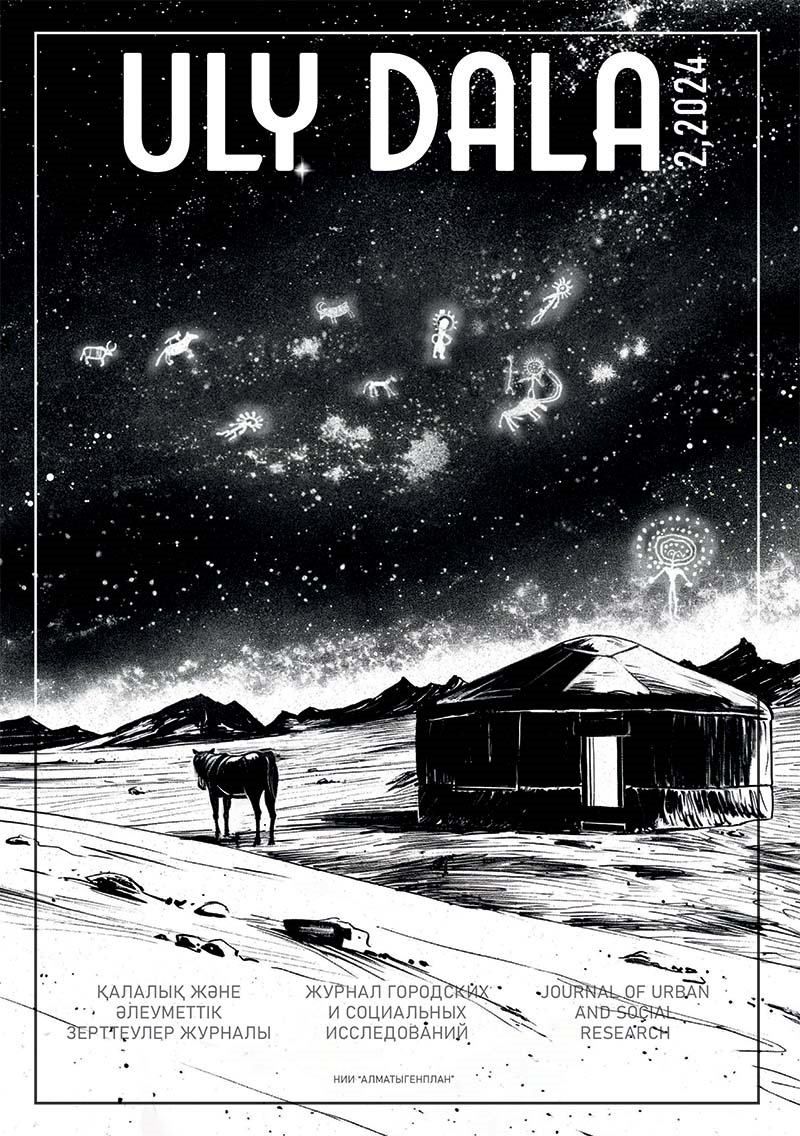Қылмыс болған жерді өзгертуге болмайды ма? Астана және Алматы қалаларындағы ауыр емес ұрлық пен зорлық-зомбылық қылмыстарының кеңістікте таралуын кешенді талдау
Тірек сөздер:
криминология, кеңістіктегі қылмыс үлгілері, дәлелді саясат, зорлық-зомбылық қылмысы, мүліктік қылмыс, ыстық нүктелерАңдатпа
Бұл мақала Қазақстанның екі ірі мегаполисінде, Астана мен Алматыда, ауыр емес ұрлықтар мен күш көрсетіп жасалған қылмыстардың бөлінуін кешенді зерттеуді ұсынады. Біз қылмыс феноменін әртүрлі аспектілерде қарастырамыз: қылмыстардың кеңістіктік паттерндерін, қалалардың «ыстық нүктелерін», олардың соңғы 5 жылдағы динамикасын, әртүрлі қылмыстардың сипаттамаларын ескере отырып, олардың әдеттегіден көп қылмыс болатын кеңістіктің сипаттамаларымен (тұрғындар саны, жылжымайтын мүліктің орташа құныжәне т.б.) және аумақпен байланысын талдаймыз. Талдау нәтижелері полицияның профилактикалық жұмысын жоспарлау кезінде, сондай-ақ Астана мен Алматы аумағындағы қылмыстық жағдайды және оның динамикасын жалпы түсіну үшін пайдалы болуы мүмкін.
Библиографиялық сілтемелер
Andresen, Martin, & Jordan Wong. (2023). The influence of micro-places on
the spatial patterns of property crime in Vancouver, Canada. International
Journal of Comparative and Applied Criminal Justice.
BBC. (2021). Hotspot policing cuts Southend crime by 74%, says Essex force.
https://www.bbc.com/news/uk-england-essex-58591105
Bowers, Kate. (2014). Risky facilities: Crime radiators or crime absorbers? A
comparison of internal and external levels of theft. Journal of Quantitative
Criminology, 30, 389—414.
Brantingham, Patricia, & Paul Brantingham. (1995). Criminality of place. European journal on criminal policy and research, 3(3), 5—26.
Eck, John, Spencer Chainey, James Cameron, Michael Leitner, & Wilson Ronald. (2005). Mapping Crime: Understanding Hot Spots.
Farrell, Graham, Nick Tilley, & Andromachi Tseloni. (2014). Why the crime
drop? Crime and justice, 43(1), 421—490.
Felson, Marcus, Yanqing Xu, & Shanhe Jiang. (2022). Property crime specialization in Detroit, Michigan. Journal of Criminal Justice.
Fortin, Marie-Josee, & Mark Dale. (2009). Spatial autocorrelation. The SAGE
handbook of spatial analysis, 89—103.
Garcia, Marie R., Ralph B. Taylor, & Brian Lawton. (2007). Impacts of violent
crime and neighborhood structure on trusting your neighbors. Justice Quarterly, 24(4), 679—704.
Getis, Arthur, & Keith Ord. (1992). The analysis of spatial association by use
of distance statistics. Geographical analysis, 24(3), 189—206.
Gill, Charlotte, Alese Wooditch, & David Weisburd. (2017). Testing the “Law
of Crime Concentration at Place” in a Suburban Setting: Implications for
Research and Practice. J Quant Criminol 33, 519—545.
Hipp, John R, & Seth A. Williams. (2020). Advances in Spatial Criminology:
The Spatial Scale of Crime. Annual Review of Criminology, 3, 75—95.
Humanitarian Data Exchange (HDX). Kazakhstan: Population Density
for 400m H3 Hexagons. https://data.humdata.org/dataset/kontur-population-kazakhstan
Mawby, Rob C., & Alan Wright. (2012). The police organisation. In Handbook
of policing, 252—280.
Nelson, Paul. (2015). Violent and property crime trends: local and international comparisons. Bureau Brief, Issue Paper, 109.
Piquero, Alex R., David P. Farrington, & Alfred Blumstein. (2003). The criminal career paradigm. Crime and justice, 30, 359—506.
Ratcliffe, Jerry. (2010). Crime mapping: spatial and temporal challenges.
Handbook of quantitative criminology, 5—24.
Sherman, Lawrence, Patrick Gartin, & Michael Buerger. (1989). Hot Spots of
Predatory Crime: Routine Activities and the Criminology of Place. Criminology, 27(1), 27—56.
Tita, George, & Steven Radil. (2010). Making space for theory: The challenges
of theorizing space and place for spatial analysis in criminology. Journal of
Quantitative Criminology, 264, 467—479.
United Nations Office on Drugs and Crime. (2023). Victims of intentional homicide. https://dataunodc.un.org/dp-intentional-homicide-victims
U.S. Department of justice Office of justice programs. Practice Profile: Hot
Spots Policing. https://crimesolutions.ojp.gov/ratedpractices/8#mam
van Dijk, Jan, Paul Nieuwbeerta, & Jacqueline Larsen. (2021). Global crime
patterns: An analysis of survey data from 166 countries around the world,
2006–2019. Journal of quantitative criminology, 1—36.
Weisburd, David. (2015). The law of crime concentration and the criminology of place. Criminology, 53(2), 133—157.
Weisburd, David, & Anthony Braga. (2006). Hot spots policing as a model
for police innovation. Police innovation: Contrasting perspectives, 225—244.
World Population Review. (2022). Crime Rate by Country. https://worldpopulationreview.com/country-rankings/crime-rate-by-country
Wuschke, Kathryn, Martin A. Andresen, Paul J. Brantingham, Christopher
Rattenbury, & Andrew Richards. (2018). What do police do and where do
they do it? International Journal of Police Science & Management, 20(1), 19—27.


